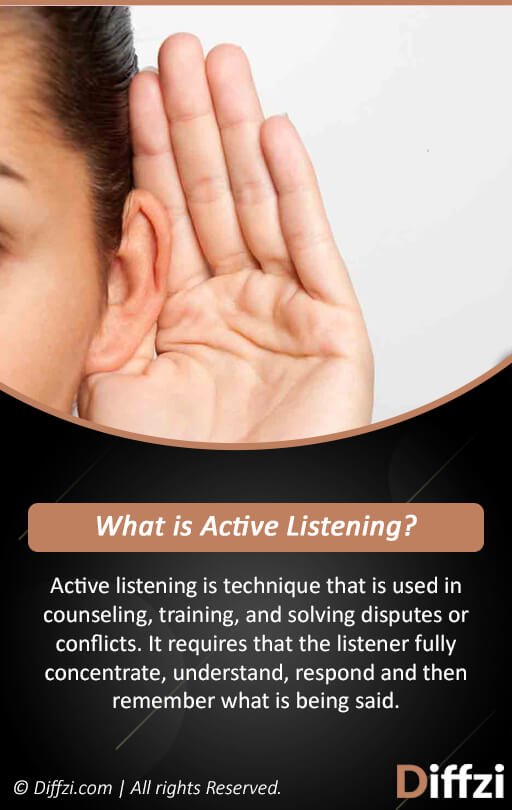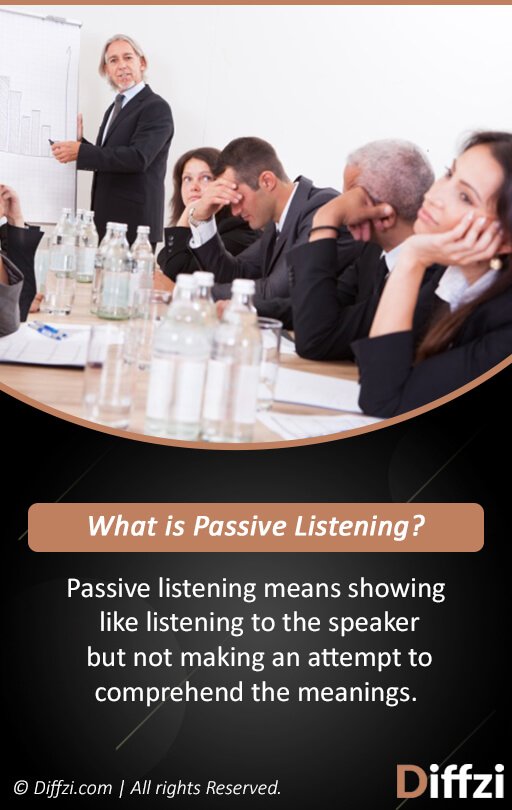The main difference between two types of communication; active listening and passive listening is that in active listening, the listener pays full attention to the speaker and his word while in passive listening, listener acts passively by receiving the message only without giving further external indications.
Comparison Chart
| Basis of Distinction | Active Listening | Passive Listening |
| Definition | Active listening means mindful and actively hearing and attempting to comprehend the meaning of the speakers. | Passive listening means showing like listening to the speaker but not making an attempt to comprehend the meanings. |
| Connectivity Level | Listener connects with the world and actively participates with the goal of problem-solving | Listener disconnects himself from the outsiders and has minimal interaction with others |
| Self-Responsibility | Take responsibility for their own learning and growth | Avoids responsibility for learning and problem-solving |
| Mental Approach | Sharp mind, alert to explore, reflect on the information | Accepts and retain information as-is with no intention to question or challenge the idea for improvement |
| Self-Motivation Level | Strong | Week |
| Engagement Level | High | Low |
| Will-Power | Strong-willed, interested in new ideas, open-minded | Narrow-minded, low or no will power, unreceptive to new ideas |
What is Active Listening?
Active listening is a form of listening communication where listeners actively listen and respond to the speaker. It is not necessary that when two persons are communication, they are listening each other actively. Half listening and half thinking are common distractions that occur. In both personal and professional life, listening is one of the most skills that a person must have. It can impact on your job effectiveness and the quality of relationships with others. To improve the level of active listening, you must pay attention to the other person. Make it sure you are trying not to distract easily. Business analyst suggests that if you want to increase your concentration level on what is saying on by the speaker, then he must try repeating speaker’s words mentally as he says them – this will reinforce his message and help you stay focused. To enhance listening or active listening skills, you need to allow the other person that you are listening to him. Active listening not stands for focusing on what the speaker is speaking about but also actively showing verbal and non-verbal signs of listening. This kind of listening is widely used in multiple situations like community organizing, public interest advocacy, tutoring, counseling, etc.

What is Passive Listening?
Passive listening is the listening where a person although listen to the others but not with full attention, he often distract himself from the ongoing discussion. He is sitting quietly without responding to what the speaker is saying. A common example of passive listening is listening to music or radio when you are doing something. In this scenario, although the music is running the listener is paying full attention to other work. To get engage with the speaker, quite often passive listening may require a few open-ended replies from the listeners, however, this technique requires focused concentration and minimal verbal feedback from the listener. Passive listening occurs when the listener has low self-motivation level, low engagement and avoids responsibility for learning and problem-solving. In passive listening, the listener accepts and retain information as-is with no intention to question or challenge the idea for improvement. He disconnects himself from others or shows minimum interest. By doing this, he creates the impediments for himself because in a time of need he forgets about what was said earlier. Overall, passive listening requires the listener to sit back quietly and absorb information contrasting active listening that requires engagement with the speaker as well.

Key Differences between Active Listening and Passive Listening
- In active listening, the listener shows interest through tone, eye contact and body language. While in passive listening, the listener is not involved, have a selective and ignoring attitude.
- Active listening is for listening for feelings and reflects understanding while passive listening results in a distraction from the topic.
- Generally, in active listening, we are genuinely interested hearing and understanding the other person’s point of view. While in passive listening we assumed that we have heard and understood correctly, but stay passive and don’t take measure to verify that.
- Active listening is a two-way communication because both speaker and listener are interacting with each other while passive listening is a one-way
- In active listening, the listener pays full attention by commenting, challenging the ideas and asking questions, whereas, in passive listening, the listener doesn’t react at all.
- Active listening requires effort because the listener has to be attentive while passive listening doesn’t require much effort.
- In passive listening, the listener only listens, whereas, in active listening, listener keeps himself in other activities like analyzing, evaluating and summarizing.
- Active listeners give more time to listening than talking while the passive listener listens to a few words and talk more or pay no attention to both areas.
- Active listener engages in intellectual exchange while passive listener hides or denies any form of intellect avoiding debates or giving options.
- Active listening means an open-minded, strong willed and having an interest in new ideas. Passive listening means being narrow-minded and unreceptive to new ideas.
- An active listener is always strong self-motivators who strive for personal development while the passive listener needs external reinforcement to be motivated.
- Active listening involves being shaped mind and often alert to explore, question and reflecting on the information. In passive listening, listener accepts and retains information as is with no intention to question or challenge the idea for improvement.
Nyc
Helpful
This explains why I get so frustrated with my partner. He will actually
have his eyes on the tv behind me or another visual distraction but argue that he has heard everything I hav ed said.
it tells me the bonfide and its helpful …….thanks
It’s very helpful. Thankss